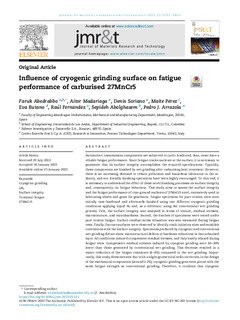Title
Influence of cryogenic grinding surface on fatigue performance of carburised 27MnCr5Author
Other institutions
Universidad de los Andes (Venezuela)Sidenor I+D
Centro Ricerche Fiat
Version
Published version
Rights
© 2023 The AuthorsAccess
Open accessPublisher’s version
https://doi.org/10.1016/j.jmrt.2023.01.111Published at
Journal of Materials Research and Technology Vol. 23xmlui.dri2xhtml.METS-1.0.item-publicationfirstpage
1792xmlui.dri2xhtml.METS-1.0.item-publicationlastpage
1804Publisher
ElsevierKeywords
Cryogenic grinding
LN2
Surface integrity
Torsional fatigue ... [+]
LN2
Surface integrity
Torsional fatigue ... [+]
Cryogenic grinding
LN2
Surface integrity
Torsional fatigue
27MnCr5 [-]
LN2
Surface integrity
Torsional fatigue
27MnCr5 [-]
Abstract
Automotive transmission components are subjected to cyclic loads and, thus, must have a reliable fatigue performance. Since fatigue cracks nucleate at the surface, it is necessary to guarantee that it ... [+]
Automotive transmission components are subjected to cyclic loads and, thus, must have a reliable fatigue performance. Since fatigue cracks nucleate at the surface, it is necessary to guarantee that its surface integrity accomplishes the required specifications. Typically, those components are finished by wet grinding after carburising heat treatment. However, there is an increasing demand to reduce pollutants and hazardous lubricants in the industry, and eco-friendly finishing operations have been highly encouraged. To this end, it is necessary to understand the effect of these novel finishing processes on surface integrity and, consequently, on fatigue behaviour. This study aims to assess the surface integrity and the fatigue performance of cryo-ground surfaces of 27MnCr5 steel, extensively used in fabricating shafts and gears for gearboxes. Fatigue specimens for pure torsion tests were initially case-hardened and afterwards finished using two different cryogenic grinding conditions applying liquid N2 and, as a reference, using the conventional wet grinding process. First, the surface integrity was analysed in terms of texture, residual stresses, microstructure, and microhardness. Second, the batches of specimens were tested under pure torsion fatigue. Surface residual stress relaxation was also measured during fatigue tests. Finally, fracture surfaces were observed to identify crack initiation sites and establish correlations with the surface integrity. Specimens produced by cryogenic and conventional wet grinding did not show microstructural defects or hardness reductions in the carburised layer. All conditions induced compressive residual stresses, and they barely relaxed during fatigue tests. Compressive residual stresses induced by cryogenic grinding were 10–20% lower than those generated by conventional wet grinding. This decrease resulted in a minor reduction of the fatigue resistance (4–6%) compared to the wet grinding. Importantly, this study demonstrates that with a slight geometrical radio correction in the design of the mechanical components (around 2.2%), cryogenic grinding generates pieces with the same fatigue strength as conventional grinding. Therefore, it confirms that cryogenic cooling could be a potential solution to replace pollutant coolant/lubricant fluid in grinding operations. [-]
xmlui.dri2xhtml.METS-1.0.item-sponsorship
Comisión Europeaxmlui.dri2xhtml.METS-1.0.item-projectID
info:eu-repo/grantAgreement/EC/RFCS/RFCS-2018-847284/EU/Improvement of the fatigue performance of automotive components through innovative ecofriendly finishing operations/FATECOCollections
- Articles - Engineering [734]
The following license files are associated with this item:























